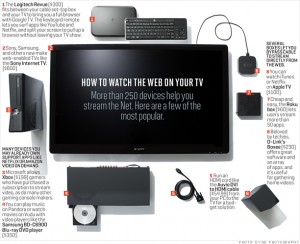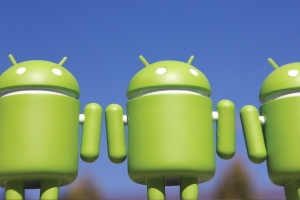Friends, online-video is going to be a fun storm in 2011 as the drama has just begun. It’s the first official business day of 2011, and that prompted me to awaken at 3:00 a.m. with great curiosity. I spent 4-plus hours diving into dozens of articles and blogs, and have wrapped it all up nicely for you. It’s my late Christmas gift.
Here are “things to watch” in early 2011, including some recent articles. See also my 2011 predictions, which is a mandatory scan. This will be on the exam.

1. The WebTV Bloodbath Is Just Beginning: Check out this killer article by Fortune’s Jessi Hempel titled “What the Hell is Going On With TV” to get a flavor for the impending drama in this space. And I quote: “Netflix, Google, and Apple can’t just swoop in and disrupt the $85 billion home entertainment industry. The challenge lies in navigating the entrenched interests that make up the television business.” Jessi’s piece reminds us that only a 1/10th of a percent of people have left cable television for the web, yet Microsoft says 42% of the premium Xbox Gold users who rely on it to view video are watching more than an hour a day, or 30 hours in a month. “If you’re a cable provider, that should be terrifying,” says Forrester analyst James McQuivey. The author points to Clicker.com as one I’d watch closely… a made-for-web TVGuide and search tool that allows you to locate various shows (Modern Family) and select viewing options: free, per episode or subscription. But Jessi likes Comcast as a driver of a mature online-video model because it protects the financial interests of content providers (as well as its own). I sadly believe she’s right given the confusing and frustrating state of online-video on television today (which she likens to Internet circa 1998). Fortunately we’ve got two forces to keep Comcast motivated: consumer demand and willing startups ready to meet that demand. And he, Comcast has been asked to be cool (see Bloomberg/Businessweek article).

2. Online-Video Platforms Continue to Get Commoditized, Then Interesting. Frankly I’ve never been as interested in the boring infrastructure supporting online video as I am the marketing, community and content that sits on top of it (where the air is easier to breath). But Streaming Media’s Dan Rayburn explains it well. Sure the space is commoditized, but just because YouTube is free doesn’t mean online-video platform vendors can’t charge a premium for more flexible solutions that can scale and provide unique functionality. According to Rayburn’s “Commoditization Is Not a Dirty Word,” vendors are shifting from talking about how they encode or embed (yawn) and how they a) integrate with ad networks and analytics, b) deliver the right video content to the right user on the right device. That makes sense, and I would not underestimate the power of a platform that meets the needs of creators and advertisers (David Russek‘s SevenEcho, for instance, is one of the best-kept secrets for storytellers and brands). There’s a wide opening for a video platform which better meets the needs of creators and advertisers (see MediaPost article by WatchMojo’s Ashkan Karbasfrooshan). The challenge, of course, is that today traffic (not content) is king, and YouTube continues to reign by miles (comScore). Thanks to music videos, Vevo and Blip.tv continue to grow — but still small fish.
3. YouTube Community Still Alive. Is YouTube a thing, destination or community? Yes, depending on whether you live there 2 hours a day or slide over to see the latest viral clip of search for a meme. Community is still alive, and the eager and weird folks from StirFryTV are cooking up a “YouTour,” a YouTube Tour which starts in Orland on a Jan. 18 event. It will include YouTube allstars Michael Buckley, Shane Dawson and CoolGuyWithGlasses. We’re not sure if John Basedow will be sneaking onto the YouTour RV, and going shirtless to each event to pitch his “Take Control Fitness Package” (making the rest of us feel like fat asses). Paul (odcasting101) remains alive with his YouTube Gathering ning. There’s a San Antonio, Texas YouTube gathering planned in June 17-June 19). While YouTube’s Creator blog has gone dry, it points to 488 YouTube gatherings listed on Meetup.com (mostly tiny ones). I just discovered YTGatherings on Twitter too, and it alerts us to such events like Jake & Amir’s Toronto event on Jan. 27, 2011. I’d be surprised if a YouTube event doesn’t spring up as part of the popular Austin, Texas SouthBySouthwest event March 11-20. After all, there are several YouTube and online-video sessions as part of the programing and Felicia Day is keynoting.
4. Video Search Will Suck Less Get Better. Sure we’ve been saying that for years, but ThinkJose’s Jose Castillo explains why video search sucks: “The internet was never designed as a platform for video… the basic structure and platform we are using to consume visual data is an outdated system originally used for sending text messages between universities.” Castillo reminded me that Blinkx.com is still around, and that Microsoft’s Bing search has a mouse-over playback (and don’t tell YouTube, but I think Bing is curating better with a homepage of videos that I regard as more relevant than what I’m finding on YouTube). He also points to CastTV, which provides blended results from YouTube, CNN, Amazon and other sites. See also Clicker.com (point one).
5. Video Greetings Will Get More Awkward in 2011: Cheesy Christmas video greetings were hot, with some being fabulous and others being downright painful. They didn’t stop, as evidenced by Profnet’s stunningly awkward 2011 New Years video. I hate to say this, but I think we’ve only begun to see how low corporate video-greeting cards can go. Sure this isn’t an “industry shaker,” but it sure will be fun to watch.
6. Video Destinations Rival YouTube: When I pop into a few well curated online-video sites, I increasingly believe YouTube, while still growing in views, will lose share in 2011. Check out Bing’s site and you’ll find a piece about Mona Lisa’s eye codes by NBC (saw it on TV last night), the “No” baby (that has viralinated), and how to break your soda habit via Howcast. That’s far more relevant than what I’m finding when I browse YouTube’s inhumanely edited topic areas, or surf my bloated subscription box. Yahoo Video is still luke warm, but I’d expect it to steal share with the shift away from consumer-generated content in March. AOL Video is still Revverish (insert tumbleweed and sound of crickets) but getting better. While YouTube focuses on being a platform, being relevant on television and mobile, and hopefully searching video better.
 7. Damn We Need Curators. It’s simply not possible to “browse” for good videos on YouTube anymore, although perhaps Google will consider some of my unsolicited New Years Resolutions for YouTube. Ultimately I’m not likely to find good content surfing the “most viewed” on YouTube (now dominated by a few niche “web stars” that appear to be “crowd sourced” by a tiny segment of apparently stoned teenage video enthusiasts). Instead, we’re more likely to find it via curators like eGuiders. Why aren’t we seeing more curators (see NYTimes blog on subject from last year). For instance, ReelSEO’s Jeremy Scott carefully selected some fantastic viral highlights from last year. That was more helpful to me than combing through YouTube. I wrote a lot about curating in Beyond Viral; go buy that dang book so I’m not the laughing stock of Wiley. Hitwise’s Bill Tancer saw the migration of early YouTubers to curated content sites a year ago, but it’s been oddly quiet.
7. Damn We Need Curators. It’s simply not possible to “browse” for good videos on YouTube anymore, although perhaps Google will consider some of my unsolicited New Years Resolutions for YouTube. Ultimately I’m not likely to find good content surfing the “most viewed” on YouTube (now dominated by a few niche “web stars” that appear to be “crowd sourced” by a tiny segment of apparently stoned teenage video enthusiasts). Instead, we’re more likely to find it via curators like eGuiders. Why aren’t we seeing more curators (see NYTimes blog on subject from last year). For instance, ReelSEO’s Jeremy Scott carefully selected some fantastic viral highlights from last year. That was more helpful to me than combing through YouTube. I wrote a lot about curating in Beyond Viral; go buy that dang book so I’m not the laughing stock of Wiley. Hitwise’s Bill Tancer saw the migration of early YouTubers to curated content sites a year ago, but it’s been oddly quiet.
8. Online Video Gets More Social. I didn’t hit that hard enough in my 2011 predictions, so let me point to Hitwise’s report about Facebook driving the social engine of the Internet. Basically Facebook’s growth hasn’t slowed down, and MySpace and Bebo are crumbling. YouTube, surprisingly, is flat relative to Facebook. I’m telling you… watch for Facebook offering revenue sharing and see if the YouTube community shifts over to Facebook. Daneboe’s cracked Facebook via the insanely popular Annoying Orange with nearly 7 million “likes” (compared to only 1.5 million YouTube subscribers despite his 423 million views). Currently Daneboe uses Facebook to alert fans to a video, then streams it on YouTube where he generates a percentage of income. How easy would it be for him to start using Facebook if the company revenue shared? Most of us YouTubers haven’t cracked Facebook yet, and it’s high time for that. NYTimes Tech Blogger, Miguel Helft, also points to Clicker.com (someone’s doing good PR) for socializing video.
 9. You’re Going to Pay More for Broadband: Video will soon dominate the percent of Internet traffic (see 2011 “Year Ahead In IT,” point 6). You .o5 percent of cable snippers are draining the economic system like illegitimate welfare recipients or those pesky entitled Boomers looking for social security payouts. Sure maybe there will be a poor-man’s broadband solution, but the rest of us are going to pay. With broadband suckers like Netflix and the new Skype iPhone Video one-to-one apps, do you honestly think telecommunication firms and broadband providers aren’t going to get wise? The U.S. is 18th in the world for speed, and we can bet that’s going to get some attention despite the historical year-over-year flat cost of broadband.
9. You’re Going to Pay More for Broadband: Video will soon dominate the percent of Internet traffic (see 2011 “Year Ahead In IT,” point 6). You .o5 percent of cable snippers are draining the economic system like illegitimate welfare recipients or those pesky entitled Boomers looking for social security payouts. Sure maybe there will be a poor-man’s broadband solution, but the rest of us are going to pay. With broadband suckers like Netflix and the new Skype iPhone Video one-to-one apps, do you honestly think telecommunication firms and broadband providers aren’t going to get wise? The U.S. is 18th in the world for speed, and we can bet that’s going to get some attention despite the historical year-over-year flat cost of broadband.
10. Google Going Beyond YouTube. Despite the GoogleTV Sony/Logitech launch running into a mix of praise and hiccups — reworking software and media-company resistance, we can expect Google to go beyond YouTube in 2011. Check out Information Week’s predictions on what Google will do this year. Among them: going Hollywood. That appears a difficult but inevitable play for Google to “organize the world’s information,” when you recognize “big media” as a large, sustainable chunk of it.
Finally take note of NewTeeVee’s Liz Shannon Miller’s poll about what force will really impact the space. Most votes are not for Hulu, Netflix, TV Everywhere, Apple or Google… most of us believe the real “shake up” or transformation will be driven by… something else. If YouTube and Facebook’s relative overnight success taught us anything about this still-maturing market, it’s that where there are problems and unmet consumer needs, there’s always something sudden and new that can keep it interesting.







